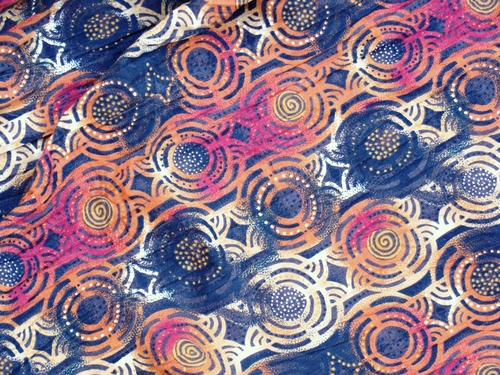Dye sublimation is a printing process in which heat is used to transfer dye onto paper, plastic, and fabric. Most commonly found in the form of a large format inkjet printer with specially formulated inks, this method of printing can be achieved by using a variety of tools such as thermal printers, offset printers, monochrome laser printers, and screen printing transfers. Many of these processes work in a similar manner:
- The image is reversed and printed onto heat resistant transfer paper. This type of dye has little to no color before being heated so your transfer image will look very different from the finished result.
- Flat cardboard or heat-resistant plastic is placed inside the garment or between layers of fabric in order to prevent bleed through. As these dyes cannot be removed, it is very important to lay out the fabric very carefully and ensure that areas you do not want printed are properly protected. Creases or unprinted areas will leave white streaks of undyed fabric.
- High pressure and a heat of 180°-210°C are applied to transfer the dye from the paper into the fabric. This turns the solid dye particles into a gas which penetrates the fibers of your fabric and binds with polymers for a permanent image.
As the dye is formulated to only bind with polymers, fabrics with higher polyester content will produce brighter images by allowing for better bonding. Because of this, only polyester based fabrics will work for dye sublimation and this method of printing cannot be used on cottons. It also means that this dye cannot be used on dark colors and, once applied, is permanent as it penetrates into the fibers rather than sitting on top as an ink would.
Best fabrics for your project
The best fabric for a specific dye sublimation project depends on what you wish to make: Polyester is often used for aprons while a polyester twill blend is preferred for cushion covers, sheets, or other bedding and upholstery. Cotton-feel polyester can also be used for high end pillowcases, napkins, and table cloths. Ribstop and polyester suede are also available for some projects and art canvas can be used to print artwork.
Different dye sublimation inks and coatings
There are three popular variants of dyes used for the dye sublimation process and, while they each have their pros and cons, the process for application is largely the same: coated transfer paper releases ink into fabric.
Solvent-based and oil-based inks were used historically due to difficulties experienced with used water-based inks such as wrinkles in large prints. The availability of compatible print heads and transfer paper limit the usage of water-based inks despite their more eco-friendly formulation. When grand-format printers were originally designed there were not very many print head choices which greatly limited the ink choices available.
Fabric enhancers, prep sheets, and sprays can sometimes be used to improve the printing quality on a certain type of fabric. These add additional polymers for the dye to bond with and work best on 50/50 blends which already have some polyester. This will create a brighter image and ensure the dye does not release from the fabric after printing.
Advantages of the dye sublimation printing process
While dye sublimation may not be the ideal choice for every occasion, there are many advantages to this process compared to Other fabric printing options other fabric printing options including:
- Retaining the original feel and texture of the fabric for more comfortable clothing, bedding;
- A high-end appearance which gives a feeling of quality;
- Crisp, photo-quality images;
- A superior end result; and
- Permanent images that will not be rubbed, cracked, or washed away.
Disadvantages
Despite its wide variety of practical uses, dye sublimation is not suited to every fabric or situation and has some drawbacks of its own including:
- No chance to correct errors in printing: once set the image is permanent;
- Cannot be used on natural fibers;
- Cannot be used on dark materials; and
- May leave white streaks of unprinted fabric at seams and joints.
Dye sublimation is overall a great method of creating a wide variety of printed fabric items from clothing to bedding to upholstery and art. Any manmade textiles such as polyester, spandex, lycra, and blended textiles can be used to create a soft printed image well suited to fabric banners, flags, tents, sails, car covers, curtains, window blinds, light shades, chair covers, clothing such as sports jerseys and t-shirts, table skirts or covers, tension fabric displays, pop up fabric displays, and fabric hanging structures.
Clinton Haglund who rose from Toronto in the year 1981. He completed his Masters in Business Administration from Rot man school of management in Toronto. He had a great passion to business and currently he is running a business in Ontario. Clinton has a knack for helping ambitious business people and to determine how they can get more with less by focusing and refining their business strategy and processes.

